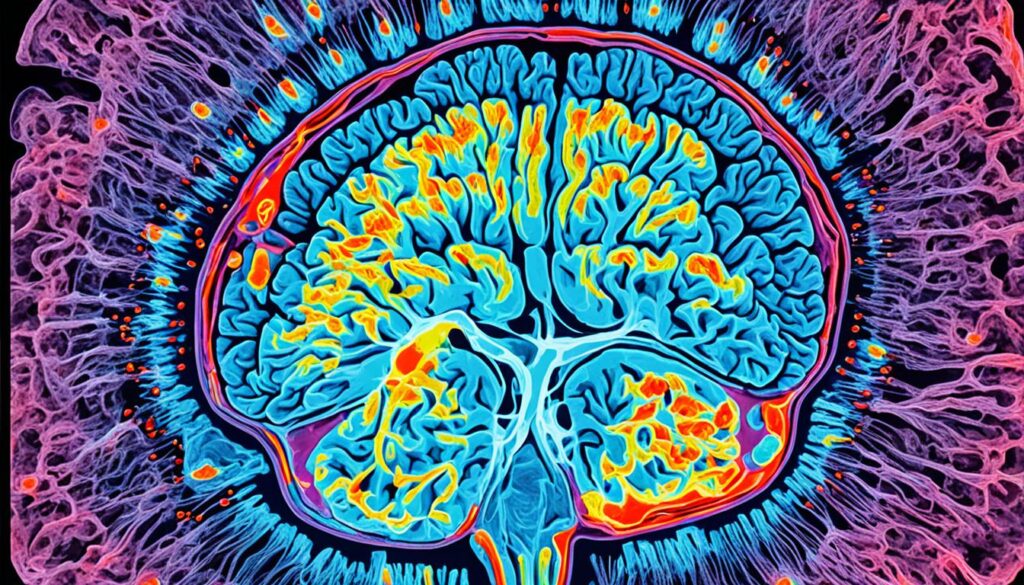Our research delves into the fascinating emotional lives of pets, unveiling new scientific insights into the psychology and behaviors of our beloved companions. Scientific research has shown that pets experience a wide range of emotions, dispelling the myth that animals lack complex emotional states. Animals, like people, can display empathy, show signs of loss, and even suffer from anxiety. Understanding and respecting the emotional needs of our pets is essential for developing a caring and supportive environment for them.
Key Takeaways
- Pets experience a wide range of emotions, including happiness, love, fear, and grief.
- Animals can display empathy and form strong emotional bonds with their human companions.
- Recognizing the complex emotions in pets is crucial for understanding their psychological needs.
- The human-animal bond is a unique and powerful connection that can impact the emotional well-being of both the pet and the owner.
- Providing a supportive environment that meets the physical and emotional needs of pets is essential for their overall well-being.
Understanding the Emotional Intelligence of Animals
Our beloved pets are capable of experiencing a diverse range of emotions, from the joyful exuberance of wagging tails and purring contentment to the heartbreaking displays of fear, grief, and anxiety. Scientific research has delved deep into the emotional intelligence of animals, shattering the long-held misconception that our companion animals lack complex feelings. By recognizing the emotional capabilities of pets, we can develop a more profound understanding of their psychological needs and create a supportive environment that addresses their emotional well-being.
Recognizing Complex Emotions in Pets
Studies on animal behavior have revealed that our furry, feathered, and scaled friends are capable of experiencing a wide array of emotions, including happiness, love, sadness, and even empathy. From the wagging tail of a dog greeting its beloved owner to the contented purr of a cat napping in the sun, these outward displays are a testament to the emotional depth of our pets. Decoding pet behavior and communication is crucial for pet owners to gain insights into the emotional states of their companions and provide them with the care and support they require.
Empathy and Emotional Bonds with Companion Animals
The human-animal bond is a unique and powerful connection that can have a profound impact on the emotional well-being of both the pet and the owner. Pets have the capacity to form strong emotional attachments with their human companions, and research has shown that they can even display empathy, responding to the emotional cues and distress of their owners. Recognizing and nurturing these emotional bonds is essential for fostering a supportive and enriching environment for our beloved pets, as well as enhancing our own emotional and psychological well-being.
By understanding the emotional intelligence of animals, we can better cater to the psychological needs of our pets and strengthen the unique human-animal bond that enriches our lives. With compassion and respect for the complex emotions of our companion animals, we can create a world where pets thrive, and the bond between humans and their animal friends continues to grow stronger.
The Science of Pet Emotions
The field of neuropsychology has provided valuable insights into the emotional lives of our companion animals. Researchers are utilizing advanced techniques, such as electroencephalogram (EEG) testing, to gain a deeper understanding of the neural activity and brain waves associated with different emotional states in pets. By decoding pet behavior and communication, scientists are better equipped to unravel the complex cognitive and emotional processes that underlie the behavior of our cherished animal friends.
Neuropsychology of Pet Emotions
Through the lens of neuropsychology, we are unveiling the intricate workings of the animal mind. Studies have revealed that pets, much like humans, possess the capacity for a wide range of emotions, including happiness, fear, and even empathy. By analyzing the brain waves and neural pathways of our companion animals, researchers are gaining unprecedented insights into the biological underpinnings of pet emotions, paving the way for more effective methods of supporting their mental health and well-being.
Decoding Pet Behavior and Communication
Understanding the nuances of pet behavior and communication is crucial for fostering a deeper connection between humans and their animal companions. By studying the various physical and behavioral cues exhibited by pets, scientists are deciphering the complex emotional language that our four-legged friends use to express themselves. This knowledge not only enhances our ability to empathize with and respond to the emotional needs of our pets but also strengthens the human-animal bond that is so integral to their overall well-being.

| Key Insights from the Neuropsychology of Pets | Implications for Enhancing Pet Emotional Well-Being |
|---|---|
| Pets experience a range of complex emotions, including happiness, fear, and empathy. | Understanding the emotional capabilities of pets allows us to provide a more supportive and nurturing environment to meet their psychological needs. |
| Brain wave analysis reveals the neural activity associated with different emotional states in companion animals. | Identifying the neurological underpinnings of pet emotions can inform the development of effective interventions and treatments for improving their mental health. |
| Decoding pet behavior and communication helps us interpret the emotional language of our animal friends. | Enhancing our ability to read and respond to pet emotional cues strengthens the human-animal bond and fosters deeper connections between pets and their owners. |
Impact of Human-Animal Interactions
The interactions between humans and their pets have a profound impact on the emotional well-being of both. Positive interactions, such as gentle touch, play, and affection, can strengthen the human-animal bond and improve the pet’s overall emotional state. These positive experiences help reinforce the emotional connection between pets and their human companions, promoting the pets’ mental health and psychological well-being.
Positive Interactions and Strengthening Bonds
When we engage in positive interactions with our pets, such as petting, cuddling, or participating in playful activities, we are nurturing the human-animal bond and contributing to the emotional well-being of our furry friends. These interactions help relieve stress, reduce anxiety, and foster a sense of trust and security in our pets. By prioritizing positive interactions, we can strengthen the emotional ties that bind us to our companion animals, creating a mutually beneficial relationship that supports the mental health of both pets and their owners.
Negative Interactions and Their Consequences
Conversely, negative interactions, such as neglect, harsh training methods, or even physical abuse, can have detrimental effects on the emotional state of our pets. These negative experiences can cause fear, anxiety, and even hostility in animals, weakening the human-animal bond and leading to long-lasting consequences on the pet’s emotional well-being. It is essential to recognize the impact of negative interactions and strive to create a supportive, nurturing environment that prioritizes the emotional needs of our beloved pets.
By understanding the profound impact of human-animal interactions on the mental health and emotional well-being of our pets, we can take proactive steps to foster positive relationships and provide our companions with the care and support they require to thrive. Recognizing the complex emotional lives of our pets and respecting their emotional needs is a crucial aspect of responsible pet ownership and a key to strengthening the unbreakable bond between humans and their animal friends.
Stress and Anxiety in Pets
As beloved members of our families, it’s crucial to understand that pets can experience stress and anxiety, just like their human companions. Recognizing the causes and signs of these emotional states in our animal friends is essential for providing them with the support and care they need to thrive.
Causes of Stress in Domestic Animals
Pets can become stressed due to a variety of factors, including changes in their routine, exposure to unfamiliar environments, loud noises, and even interactions with their human caregivers. Transitioning to a new home, the arrival of a new family member, or the introduction of a new pet can all be potential stressors for our furry friends. It’s important to be attuned to these triggers and make adaptations to create a more stable and comfortable environment for our pets.
Recognizing Signs of Stress and Anxiety
Identifying the physical and behavioral indicators of stress and anxiety in pets is crucial for addressing their emotional well-being. Dogs may display signs such as frequent barking, whimpering, trembling, or destructive behavior, while cats may exhibit withdrawal, litter box problems, or changes in their grooming habits. By recognizing these signs, we can take proactive steps to address the underlying causes and provide our pets with the support they need to feel safe, secure, and emotionally balanced.
Creating a Supportive Environment for Pets
Providing a safe, secure, and comfortable environment is essential for the emotional well-being of our pets. This includes meeting their basic physical needs, such as nutritious food, clean water, and regular exercise, as well as their emotional needs, such as affection, companionship, and a sense of security.
Meeting Physical and Emotional Needs
To create a supportive environment for pets, it’s crucial to address both their physical and emotional needs. This means ensuring that our furry friends have access to high-quality nutrition, clean living spaces, and opportunities for regular activity and play. Just as importantly, we must also prioritize their emotional needs, providing them with love, attention, and a strong sense of belonging within our homes.
Providing Mental Stimulation and Enrichment
In addition to meeting the basic physical and emotional requirements of our pets, it’s also essential to offer them mental stimulation and enrichment. This can be achieved through interactive toys, puzzle feeders, and a variety of engaging activities that challenge their minds and prevent boredom. By catering to the emotional needs of pets and providing them with opportunities for mental stimulation and pet enrichment, we can help reduce anxiety, promote overall well-being, and strengthen the bond between our beloved companions and ourselves.

The Importance of Socialization
Proper socialization is a crucial component in the emotional and behavioral development of our pets. During the formative early stages of a pet’s life, exposing them to a variety of people, animals, and environments can have long-lasting benefits, including improved social skills, increased confidence, and better adaptability to new situations.
Early Socialization and Its Benefits
The importance of pet socialization cannot be overstated, as it helps to reduce fear and anxiety later in life, contributing to the overall emotional well-being of our beloved companions. By introducing pets to positive experiences and new experiences in a controlled and nurturing manner, we can help them develop the skills necessary to thrive in a variety of settings.
Exposing Pets to New Environments and Experiences
Exposing our pets to a wide range of environments and experiences during their formative years is a crucial aspect of early socialization for pets. This exposure not only helps them become more adaptable and confident, but it also enhances their ability to cope with stressful situations that may arise throughout their lives. By prioritizing the benefits of pet socialization, we can foster the emotional well-being of our beloved companions and strengthen the bond we share.
Addressing Behavioral Issues in Pets
Pets may sometimes develop behavioral issues that can be challenging to manage. These behavioral problems can stem from a variety of factors, such as stress, lack of socialization, or underlying medical conditions. It is important to recognize common pet behavior problems, such as excessive barking, destructive behavior, or aggression, and to understand their potential causes.
Common Behavioral Problems and Their Causes
Excessive barking, destructive chewing, and aggression are just a few examples of common pet behavior problems that pet owners may encounter. These issues can often be traced back to stress, inadequate socialization, or even medical problems that are impacting the pet’s emotional well-being. Understanding the root causes of these behavioral issues in pets is the first step in addressing them effectively.
Seeking Professional Assistance for Challenging Behaviors
In cases where pet owners are unable to effectively address behavioral issues in pets on their own, seeking the assistance of professional pet psychologists, veterinarians, or licensed animal behaviorists can provide valuable insights and interventions to help improve the emotional well-being of pets. These experts can offer specialized guidance and tailored solutions to address the causes of pet behavior problems and support the long-term emotional well-being of the pet.

Animal-Assisted Interventions and Therapy
The use of animal-assisted interventions and therapy has gained increasing recognition for its potential to improve the emotional and psychological well-being of both humans and animals. These therapeutic approaches involve the incorporation of specially trained animals into various clinical, educational, and social settings to enhance the overall health and well-being of individuals.
Benefits of Animal-Assisted Therapy
Numerous studies have demonstrated the diverse benefits of animal-assisted therapy. Participants in these programs often experience reduced stress and anxiety, improved social skills, and enhanced mood. The presence of a calm, friendly animal can have a calming effect, helping to alleviate feelings of anxiety and stress. Additionally, the opportunity to interact with and care for an animal can foster a sense of purpose and strengthen emotional bonds, contributing to improved social and emotional well-being.
Safety Considerations in Animal-Assisted Interventions
While the potential benefits of animal-assisted interventions are well-documented, it is crucial to consider the safety of both the human participants and the animals involved. Ensuring the emotional and physical well-being of the animals is of paramount importance. Rigorous safety protocols, comprehensive animal welfare assessments, and proper training for both the animals and their handlers must be in place to prevent any potential harm or distress to the animals. Additionally, careful screening and preparation of human participants, as well as clear guidelines for interaction, are essential to maintain a safe and positive experience for all involved.
Research Advancements and Future Directions
The field of pet psychology and the study of human-animal interactions is rapidly evolving, with ongoing research exploring new frontiers in this fascinating area. Researchers are conducting studies to gain a deeper understanding of the neurological and psychological processes underlying pet emotions, as well as the impact of various types of interactions on the emotional well-being of both humans and animals.
Current Studies on Human-Animal Interactions
Researchers are delving into the complexities of research on human-animal interactions, examining how different types of interactions, from physical touch to play and training, can influence the emotional well-being of pets. These studies aim to provide valuable insights into the current studies on pet emotions and the ways in which our relationships with companion animals can shape their psychological and social development.
Exploring the Potential of Animal-Assisted Therapies
As the scientific community continues to uncover new insights, the potential for innovative animal-assisted therapies and interventions to improve the lives of pets and their human companions is poised to grow, offering exciting possibilities for the future. Researchers are exploring the ways in which animal-assisted interventions can be leveraged to address a wide range of emotional and psychological needs, from reducing stress and anxiety to enhancing social skills and overall emotional well-being of pets.

Ethical Considerations in Pet Care
Responsible pet ownership involves more than just providing for the physical needs of our animal companions; it also requires an understanding and respect for their emotional needs and well-being. As pet owners, we have an ethical obligation to recognize and address the emotional states of our pets, ensuring that they are living in a supportive environment that meets their psychological and social needs.
Responsible Pet Ownership and Emotional Wellbeing
This includes acknowledging our pets’ capacity for complex emotions, providing them with positive interactions and experiences, and making decisions that prioritize the overall welfare and emotional well-being of our beloved companion animals. By fostering an environment that caters to their emotional needs, we can build stronger bonds and ensure that our pets thrive both physically and mentally.
Respecting the Emotional Needs of Companion Animals
Recognizing the emotional intelligence of our pets and respecting their emotional needs is a crucial aspect of ethical pet care. From understanding their stress and anxiety triggers to providing mental stimulation and enrichment, we must strive to create a nurturing and compassionate environment that supports the overall well-being of our companion animals.

| Ethical Consideration | Responsible Action |
|---|---|
| Respecting Pet Emotions | Acknowledging the complex emotional capacities of pets and addressing their emotional needs. |
| Providing Enrichment | Offering mental stimulation, positive interactions, and a supportive environment to promote emotional well-being. |
| Prioritizing Pet Welfare | Making decisions that prioritize the overall health and emotional needs of our companion animals. |
Conclusion
In conclusion, the emotional world of pets is a fascinating and rapidly evolving field of study. Scientific research has revealed that our companion animals are capable of experiencing a wide range of complex emotions, challenging the long-held misconception that animals lack feelings. By understanding and respecting the emotional needs of our pets, we can develop deeper, more meaningful bonds and provide them with the supportive environment they require to thrive.
As we continue to uncover new insights into the emotional intelligence of animals, the potential for improving the lives of both pets and their human companions grows ever stronger. Responsible pet ownership and a genuine commitment to the emotional well-being of our cherished animal friends is the key to nurturing these invaluable relationships. The importance of understanding pet emotions, caring for the emotional needs of pets, and strengthening the human-animal bond cannot be overstated.
By fostering a deeper appreciation for the emotional capacities of our pets, we can create a more empathetic and compassionate society that prioritizes the emotional well-being of all sentient beings. The future holds exciting possibilities as we further explore the depths of the animal mind and find new ways to enhance the lives of our beloved animal companions.
FAQ
What emotions can pets experience?
Scientific research has shown that pets can experience a wide range of emotions, including happiness, love, fear, and grief. Pets are capable of displaying empathy and forming strong emotional bonds with their human companions.
How can we understand the emotional intelligence of animals?
Researchers are using advanced techniques, such as electroencephalogram (EEG) testing, to gain deeper insights into the neural activity and brain waves associated with different emotional states in pets. By decoding pet behavior and communication, scientists are better able to understand the complex cognitive and emotional processes that underlie the behavior of companion animals.
What is the impact of human-animal interactions on pet emotions?
Positive interactions, such as gentle touch, play, and affection, can strengthen the bond between a pet and its owner and improve the pet’s overall emotional state. Negative interactions, such as neglect or training methods centered on punishment, can cause fear, anxiety, and even hostility in animals, weakening the human-animal bond and having long-lasting consequences on the pet’s emotional well-being.
How can we recognize and address stress and anxiety in pets?
Recognizing the physical and behavioral indicators of stress and anxiety, such as frequent barking, whimpering, trembling, or destructive behavior in dogs, and withdrawal or litter box problems in cats, is crucial for addressing the underlying causes and supporting the emotional well-being of our pets. Providing a safe, secure, and comfortable environment, as well as meeting their basic physical and emotional needs, can help reduce stress and anxiety in pets.
Why is socialization important for pet emotional well-being?
Proper socialization, especially during the formative early stages of a pet’s life, can have lasting benefits, including improved social skills, increased confidence, and better adaptability to new situations. Exposing pets to a variety of people, animals, and environments in a positive and controlled manner can help reduce fear and anxiety later in life, contributing to their overall emotional well-being.
How can we address behavioral issues in pets?
It is important to recognize common behavioral problems, such as excessive barking, destructive behavior, or aggression, and to understand their potential causes. In cases where pet owners are unable to effectively address these issues on their own, seeking the assistance of professional pet psychologists, veterinarians, or licensed animal behaviorists can provide valuable insights and interventions to help improve the pet’s emotional well-being.
What are the benefits of animal-assisted interventions and therapy?
Studies have demonstrated the various benefits of animal-assisted therapy, such as reduced stress and anxiety, improved social skills, and enhanced mood. However, it is crucial to consider the safety of both the human participants and the animals involved in these interventions, ensuring that the emotional and physical needs of the animals are met and that appropriate precautions are taken to prevent any potential harm.
What are the ethical considerations in caring for pets?
Responsible pet ownership involves recognizing and addressing the emotional needs and well-being of our pets. As pet owners, we have an ethical obligation to provide a supportive environment that meets the psychological and social needs of our beloved companion animals, acknowledging their capacity for complex emotions and making decisions that prioritize their overall welfare.
Source Links
- https://newsinhealth.nih.gov/2018/02/power-pets
- https://www.cnn.com/2024/03/13/health/playing-with-dogs-affects-brain-waves-study-wellness/index.html
- https://medium.com/@itiko/pet-psychology-understanding-the-emotional-and-psychological-well-being-of-pets-f7b117c95029

